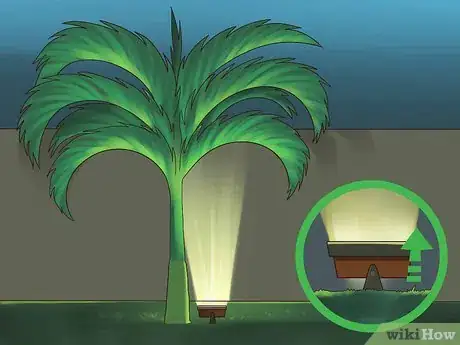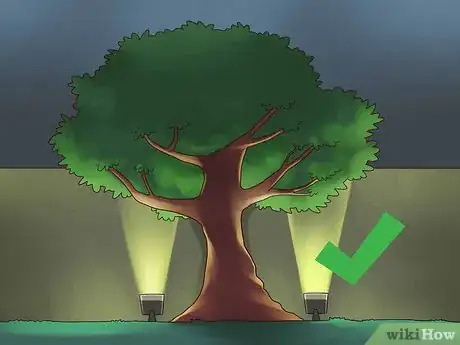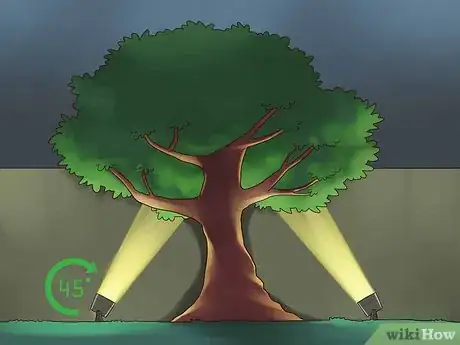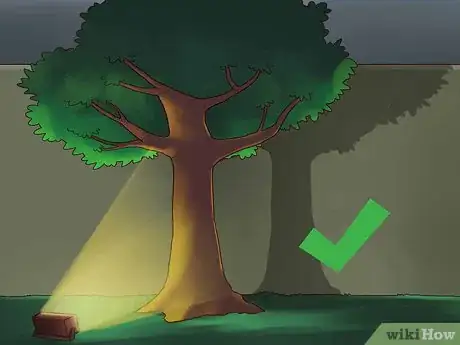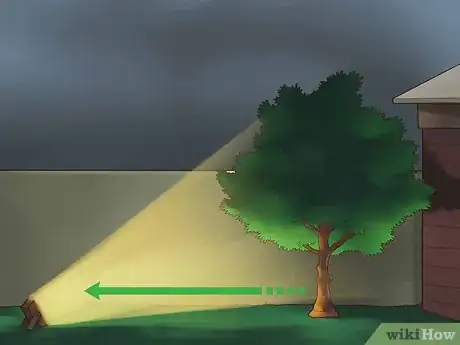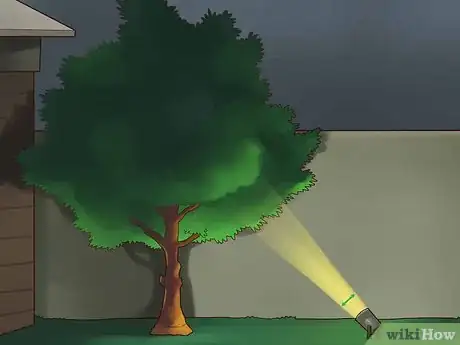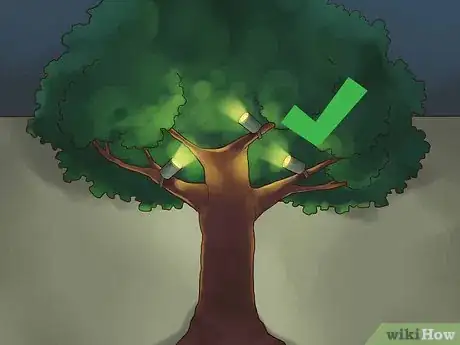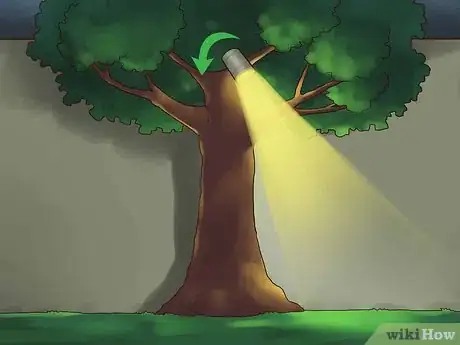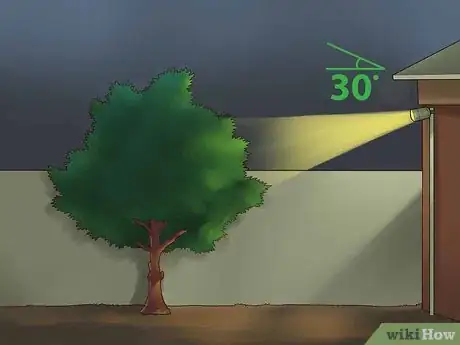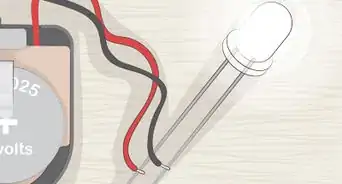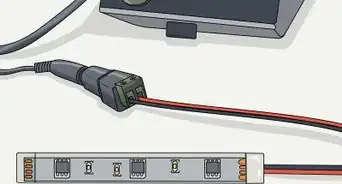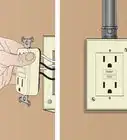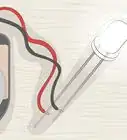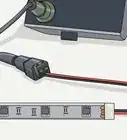This article was co-authored by Lauren Kurtz. Lauren Kurtz is a Naturalist and Horticultural Specialist. Lauren has worked for Aurora, Colorado managing the Water-Wise Garden at Aurora Municipal Center for the Water Conservation Department. She earned a BA in Environmental and Sustainability Studies from Western Michigan University in 2014.
There are 9 references cited in this article, which can be found at the bottom of the page.
This article has been viewed 118,062 times.
Outdoor lighting can make your home feel more welcoming, improve security, and beautify your landscaping. There are several different techniques that can create dramatic or welcoming atmospheres. Uplighting will cast a warm glow and highlight the intricacies of your trees while downlighting can create a dramatic scene.
Steps
Uplighting for Dramatic Effect
-
1Position an in-ground, well light directly underneath a narrow tree. Small, spindly, or narrow trees will often appear more dramatic when up-lighted. Plant in-ground lights directly next to the tree's trunk, and face them upwards. This technique gives small trees, like dwarf palms, an arresting impact despite their diminutive size.
-
2Aim a spotlight directly up the trunk of a large, bushy tree. Position the spotlight (you can use one or several) close to the tree's trunk and aim it upwards, into the foliage. This technique will highlight the intricacy of its foliage, and illuminate the texture and form of the tree's trunk and branches.
- Use this technique when you want to accent a tree with an especially interesting trunk shape.
Advertisement -
3Arrange a spotlight further away from a tree’s trunk for texture. This type of up-lighting will cast more shadows, and create a dramatic background surrounding your tree. Position the light at a 45 degree angle upwards to dramatize the tree’s trunk and foliage.[1]
Spotlighting a Focal Tree
-
1Make your tree a focal point. Use two or more spotlights to create a cross-beam of light. This will reduce shadows and cast an arresting and enchanting glow directly focused on the tree. To make the most of this technique, pick a tree that has impressive height, girth, or intricacy of branches.
- Arrange these spotlights further away from the tree than you would if you were up-lighting.
-
2Avoid spotlighting windows. Spotlights that may shine directly or indirectly into a window in your own or a neighbor’s home can be a nuisance. If a tree is near a window, try down-lighting it, instead.[2]
-
3Use spotlights as a safety feature. Try spotlighting a tree close to your front or back door, or in a part of your lawn that looks too dark. Spotlights tend to be brighter, and may deter unwelcome visitors.[3]
Silhouetting Your Trees
-
1Create dramatic silhouettes by lighting trees against walls. If you have a tree that is placed near the wall of your home, try placing a bright spotlight in front of it and aiming it towards the wall. This will cast a dramatic shadow of the tree's form onto the wall.[4]
- If lit from below, trees will cast a shadow that appears larger than the plant's actual size. For a more subtle effect, try lighting from above or using multiple lights to soften the individual shadows.
- A garage or fence can also be used as a backdrop for silhouette lighting.
-
2Use a floodlight for a large, open area. Place a floodlight far from the tree or area of lawn you wish to illuminate. Aim the light at the tree and its foliage, and towards a structure behind it. This technique is especially suited for trees with interesting shapes, as well as shrubs and topiary.
- Because this technique provides a wash of light over the wall of your house, it also increases security.
-
3Isolate focal trees. If you have multiple trees in front of a wall, place a floodlight closer to the tree you wish to silhouette. This will ensure that you project only one, distinct silhouette against the wall behind it. By choosing a focal tree, you will create a more distinct accent than if many trees were silhouetted in close proximity to each other.[5]
-
4
Downlighting Within and Around a Tree
-
1Install a small spotlight on the trunk of your tree. This will create a moonlight effect within the tree’s foliage or against its root system, depending on which direction you angle the light.[8]
- Try positioning multiple lights on a tree’s trunk. By pointing lights both upwards and downwards, you will create a fuller, more natural moonlight effect.[9]
-
2Position a swiveling spotlight within the tree's foliage. If you have a tree with lots of loose foliage, consider placing a spotlight facing downwards directly onto one of the tree's branches. This will cast enchanting shadows of the tree's foliage onto the surrounding ground, creating a dappled wash of light.[10]
-
3Shine a swiveling spotlight down on your tree. Place a light high up and away from your tree for this technique. Tilt the spotlight at a 30 degree angle to the tree for a natural looking diffusion of light—it should shine through the branches and onto the ground or foliage below it. This will also make your tree a more subtle focal point of the yard, and lend a warm glow to the tree’s surroundings.
- Conversely, this type of downlighting can also cast an eerie glow on the ground around your trees, especially in the fall and winter when foliage is more sparse.
References
- ↑ https://www.houzz.com/ideabooks/2758259/list/the-3-top-ways-to-light-up-your-landscape
- ↑ https://www.gardenista.com/posts/hardscaping-101-landscape-uplighting/
- ↑ https://www.houzz.com/ideabooks/2758259/list/the-3-top-ways-to-light-up-your-landscape
- ↑ http://www.steves-digicams.com/knowledge-center/how-tos/photography-tips/breaking-lighting-rules-backlight-and-silhouettes.html
- ↑ https://www.gardenista.com/posts/hardscaping-101-landscape-uplighting/
- ↑ https://www.wired.com/2016/03/obsessive-quest-worlds-sharpest-led-spotlight/
- ↑ http://www.diynetwork.com/how-to/skills-and-know-how/electrical-and-wiring/22-landscape-lighting-ideas-pictures
- ↑ http://www.bhg.com/home-improvement/lighting/outdoor/landscape-lighting-tips/
- ↑ http://www.bhg.com/home-improvement/lighting/outdoor/landscape-lighting-tips/
About This Article
To accent your trees, first decide whether you would like to add lighting to a few smaller trees or whether to make one tree a focal point. To create a focal point, position two or more lights a few feet away from the base of the tree to create crossbeams that highlight the tree. To accent several trees, use uplighting to emphasize the foliage or downlighting to emphasize the base of the tree. You can create silhouettes by positioning lights in front of a tree so it's shadow is cast against your home. For tips about choosing the right light bulbs and fixtures, keep reading!
